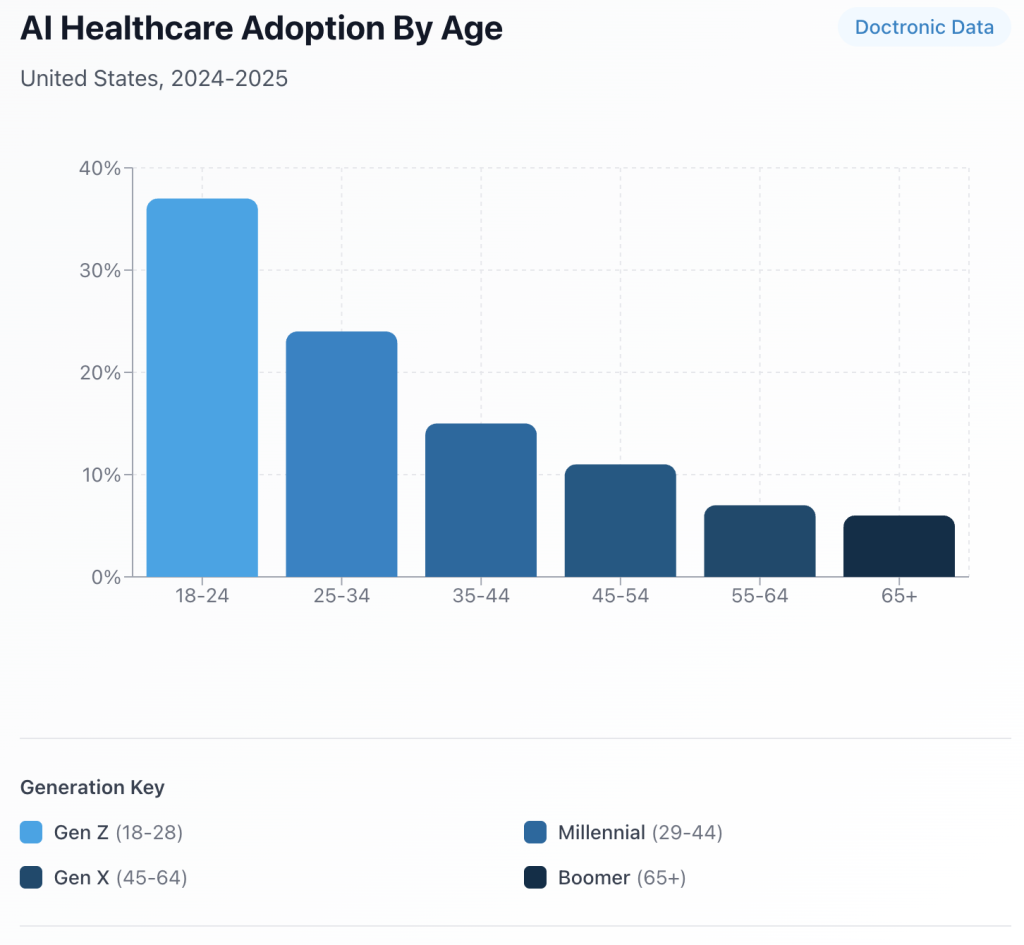
Gen Z is leading the AI healthcare revolution. Are Boomers being left behind?
Gen Z is leading the AI healthcare revolution. Are Boomers being left behind?
New data from millions of AI health consultations at Doctronic reveals a predictable but concerning gap: while Gen Z embraces digital healthcare solutions, older adults, those with the greatest medical needs, are showing the lowest rates of adoption.
Analysis of usage patterns from Doctronic's AI-powered healthcare platform shows that young adults aged 18-25 account for 37% of all consultations—more than any other age group. Meanwhile, adults over 65, who statistically require the most healthcare services, represent just 6% of users.
The data confirms what might be expected from digital natives leading technological adoption:

Why Gen Z Leads AI Healthcare Adoption
Gen Z's dominance in AI health consultations makes sense—they're digital natives who've never known a world without smartphones and instant access to information. But their adoption goes deeper than just tech comfort. It's a pragmatic response to a healthcare system that's increasingly inaccessible to young adults.
The insurance crisis hits hardest for young adults
Healthcare coverage remains elusive for millions of Gen Z adults. According to Census Bureau data, young adults aged 19-34 have the highest uninsured rate of any age group in the United States. Many age out of their parents' insurance at 26 and face a difficult reality: employer-sponsored insurance with high deductibles, expensive marketplace plans, or going without coverage entirely.
Without insurance, even a simple doctor's visit for a sore throat or skin rash can cost $150-300—money that young adults struggling with student loan debt and entry-level salaries often don't have. The result? They too often avoid care, self-diagnose using unreliable internet sources, or turn to emergency rooms for non-emergencies.
AI health platforms offer an alternative: immediate, affordable access to medical guidance without the sticker shock.
Primary care physician shortages leave young adults adrift
The physician shortage in America is well-documented, but it particularly impacts young adults who are establishing independent healthcare relationships for the first time. The Association of American Medical Colleges projects a shortage of up to 86,000 physicians by 2036, with primary care seeing shortages of 20,200 to 40,400 physicians.
For Gen Z, this means:
- Difficulty finding doctors accepting new patients
- Weeks or months between appointments
- Limited time with physicians who are overbooked
- Rushed consultations that leave questions unanswered
Digital health tools fill the gap when traditional appointments aren't available.
The 24/7 healthcare needs of digital natives
Gen Z grew up with immediate access to information. When they wonder about a medication interaction at 2 a.m. or want to understand a symptom before deciding whether to seek emergency care, they seek answers in real-time.
AI health platforms align with how Gen Z actually lives: instant, on-demand, accessible from their phones.
Financial realities drive behavior
The average cost of an in-person doctor's visit ranges from $100 to $300 without insurance. Urgent care visits run $150 - $200. Emergency room visits can exceed $1,000 for non-emergencies.
AI-powered consultations cost a fraction of traditional care—or are often free for basic questions. For young adults managing student loans, rent, and entry-level salaries, the cost difference is significant.
Trust in technology over systems
Gen Z has another distinguishing characteristic: they often trust technology more than they trust traditional institutions. They've witnessed healthcare's failures—insurance denials, surprise medical bills, physician burnout leading to poor care, and a system that often seems designed to confuse rather than help.
Digital health platforms offer transparency that traditional healthcare often lacks. The information is clear, costs are upfront, and the technology is available when needed.
The Digital Divide: Why Boomers Are Being Left Behind
Here's where the data becomes troubling: older adults—who have the highest rates of chronic conditions, take multiple medications, and utilize healthcare services more than any other age group—represent the smallest user group at just 6%.
The very population that could benefit most from accessible, always-available healthcare support is the least likely to use it.
Technology adoption barriers
The digital divide isn't just about access to devices—Boomers own smartphones at high rates. It's about comfort with new technologies, trust in AI-powered solutions, and the learning curve required to navigate digital health platforms.
Many older adults:
- Prefer in-person interactions they've relied on for decades
- Hesitate to trust AI with health decisions
- Find new technology interfaces confusing or intimidating
- Lack family members or support systems to help them adopt new tools
Boomers have come to rely on face-to-face physician visits. Shifting that mindset requires more than just technology; it requires cultural change.
Bridging the gap
The solution isn't abandoning older adults to outdated healthcare models—it's meeting them where they are. This means:
- Designing interfaces specifically for older adults
- Providing education and support for technology adoption
- Building trust through transparency about AI capabilities and limitations
- Creating hybrid models that blend digital efficiency with human connection
- Partnering with senior centers, Medicare programs, and healthcare providers who serve older populations
What This Means for Healthcare's Future
The generational divide in AI healthcare adoption signals both opportunity and challenge for the healthcare system.
The opportunity: Reimagined primary care
Gen Z's embrace of AI healthcare proves that consumers want—and will use—alternatives to traditional primary care when those alternatives are accessible, affordable, and effective. This creates opportunity to:
- Reduce the burden on overwhelmed primary care physicians by handling routine questions and concerns through digital triage.
- Expand access for underserved populations who face barriers to traditional care: rural residents, uninsured individuals, people with mobility challenges, and anyone for whom taking time off work for a doctor's appointment creates hardship.
- Improve health literacy by providing clear, personalized explanations of medical information.
Catch problems early by making it easy for people to ask questions when symptoms first appear, rather than waiting until conditions worsen.
The challenge: Ensuring equitable access
But if we're not intentional, AI healthcare could widen rather than narrow health disparities. The current adoption patterns show clear risk: young, tech-savvy, often healthier individuals access innovative care while older, sicker populations are left behind.
Healthcare innovation is only valuable if it reaches everyone who needs it. This requires:
- Proactive outreach to older adults and underserved communities
- Partnerships with traditional healthcare providers to integrate AI into existing care pathways
- Affordability that doesn't exclude anyone based on ability to pay
- Cultural competency that recognizes diverse needs and preferences
- Transparency about what AI can and cannot do
Moving Forward Together
The data is clear: Gen Z is leading a transformation in how we access healthcare. They're not abandoning quality medical care—they're demanding it be delivered in ways that align with how they live.
But we can't celebrate this revolution while leaving an entire generation behind. The goal isn't to replace traditional healthcare or to serve only the young and tech-savvy. It's to expand access, improve quality, and ensure everyone can get the healthcare support they need, when they need it.
The future of healthcare is being written right now, in millions of conversations between people and digital health tools. Gen Z is leading the way, but the challenge is ensuring older adults who need care most aren't left out of this healthcare evolution.
About the data: Analysis based on usage patterns from Doctronic's AI-powered healthcare platform, representing millions of AI consultations across all age demographics. Data reflects consultation volume by age group and does not include personally identifiable health information.
This story was produced by Doctronic and reviewed and distributed by Stacker.



